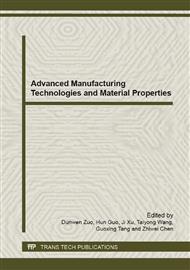[1]
P. Kurze, W. Krysmann, J. Schreckenbach, Th. Schwarz, K. Rabending, Cryst. Res. Technol. 22 (1987) 53-58.
DOI: 10.1002/crat.2170220115
Google Scholar
[2]
A.A. Voevodin, A.L. Yerokhin, V.V. Lyubimov, M.S. Donley, J.S. Zabinski, Surf. Coat. Technol. 86/87 (1996) 516-521.
DOI: 10.1016/s0257-8972(96)03069-1
Google Scholar
[3]
M. Boinet, S. Verdier, S. Maximovitch, et al. Plasma electrolytic oxidation of AM60 magnesium alloy: Monitoring by acoustic emission technique. Electrochemical properties of coatings, Surface & Coatings Technology, 199(2005)141~149.
DOI: 10.1016/j.surfcoat.2004.10.145
Google Scholar
[4]
E.V. Parfenov, A.L. Yerokhin, A. Matthews. Frequency response studies for the plasma electrolytic oxidation process, Surface & Coatings Technology, 201(2007)8661~8670.
DOI: 10.1016/j.surfcoat.2007.04.044
Google Scholar
[5]
E.V. Parfenov, A.L. Yerokhin, A. Matthews. Impedance spectroscopy characterisation of PEO process and coatings on aluminium, Thin Solid Films, (2007).
DOI: 10.1016/j.tsf.2007.06.169
Google Scholar
[6]
F. Me´cuson, T. Czerwiec, T. Belmonte, et al. Diagnostics of an electrolytic microarc process for aluminium alloy oxidation, Surface & Coatings Technology, 200(2005)804~808.
DOI: 10.1016/j.surfcoat.2005.01.076
Google Scholar
[7]
L.O. Snizhko, A.L. Yerokhin, A. Pilkington, et al. Anodic processes in plasma electrolytic oxidation of aluminium in alkaline solutions, Electrochimica Acta, 49(2004)2085~(2095).
DOI: 10.1016/j.electacta.2003.11.027
Google Scholar
[8]
L.O. Snizhko, A.L. Yerokhin, N.L. Gurevina, et al, A. Pilkington, A. Leyland, A. Matthews. A model for galvanostatic anodising of Al in alkaline solutions, Electrochimica Acta, 50(2005) 5458~5464.
DOI: 10.1016/j.electacta.2005.03.052
Google Scholar
[9]
L.O. Snizhko, A.L. Yerokhin, N.L. Gurevina, et al. Excessive oxygen evolution during plasma electrolytic oxidation of aluminium, Thin Solid Films, (2007).
DOI: 10.1016/j.tsf.2007.06.158
Google Scholar
[10]
James A. Curran, Thermal and Mechanical Properties of Plasma Electrolytic Oxide Coatings. Cambridge University, Cambridge, 2005. 抱歉,系统响应超时,请稍后再试 · 支持中英、中日在线互译 · 支持网页翻译,在输入框输入网页地址即可 · 提供一键清空、复制功能、支持双语对照查看,使您体验更加流畅.
Google Scholar


